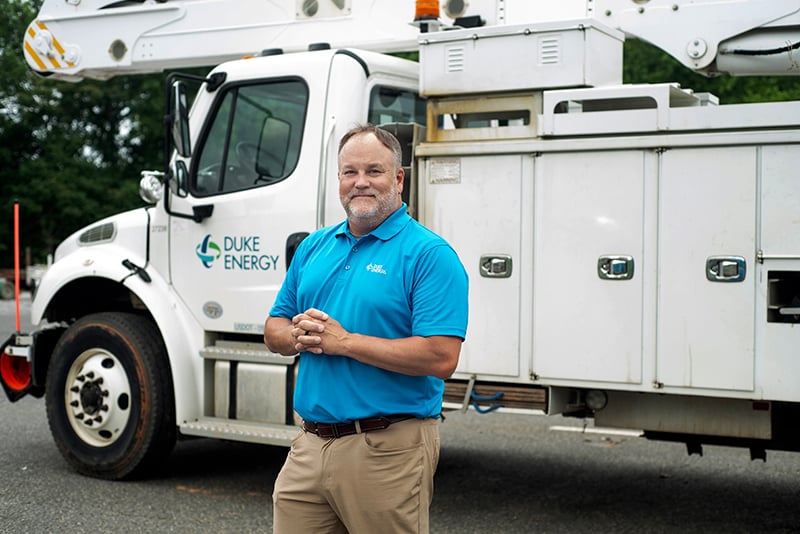At Duke Energy, He Prepares For The Worst. Here’s What He Learned Post-Helene
As the first-ever manager of emergency preparedness, Jason Hollifield faced an unprecedented test

In 2019, Duke Energy’s chief power grid officer, Scott Batson, decided the company should have someone who, in the words of Jason Hollifield, “woke up every morning thinking about what could go wrong—and went to bed every night making sure that we had prepared ourselves more effectively that day for if it did.”
Hollifield, an employee with years of experience both in the field and at headquarters in Charlotte, took the new role: general manager of emergency preparedness for power grid operations. He’s a busy guy. During disasters, he leads a team of thousands across two states. On the eve of hurricane season, which starts in June, it takes weeks to schedule an interview. But when I speak to him via Zoom in late May, he isn’t an executive in a rush. He’s generous and self-effacing. A drawl betrays his rural roots.
Hollifield’s steadfast calm makes him the right man for the job. The incident response center, on the seventh floor of uptown’s Duke Energy Plaza, gets hectic during emergencies. Stress runs high—and it was never higher than late last September, when Hurricane Helene, the deadliest mainland U.S. hurricane since Katrina, barreled into the Carolinas. In North Carolina, more than 100 people died, and the damage estimate topped $53 billion. Throughout the Southeast, more than 4.7 million homes lost power.
For weeks, Hollifield worked 18-hour days, stepping outside only to cross Tryon Street from his hotel to the incident response center in the morning and back again at night. He calls Helene the worst storm in Duke Energy’s history. But as another hurricane season ramps up, he wakes up imagining worse still—and goes to bed confident that no matter what comes, he and his team will get the lights back on.
Here’s Hollifield in his own words, edited for clarity and concision.
I grew up in rural Rutherford County. The town was called Sunshine, but it wasn’t on the map. The formal address was Bostic, North Carolina. It was a great childhood in the country. We had animals. We helped my grandfather and grandmother with their farm, raising crops—I’m maybe one of the few people in my generation to have not used mechanized equipment. I studied business management and industrial engineering at Clemson University. I loved it. I’ve always thought that Rutherford County and Clemson would be the only two places I could call home.
After I graduated, I came straight to work at Duke. I was following in my dad’s footsteps. He’d been at Duke Energy for about 30 years. He was responsible for siting and constructing transmission lines and substations. He was part of the team that helped recruit the Panthers to the Carolinas. He did transmission line modeling for public hearings. They wanted to see what a stadium sitting in downtown Charlotte would look like, and he showed them.
I came to Duke in ’95 and spent about five years working at our general office in downtown Charlotte. We’re a much larger company today than we were then. I got to go out to the field—from Anderson, South Carolina, all the way to Durham and Chapel Hill. There were a lot of people working in the general office that had been in all facets of the business, so it was a great opportunity to learn and gain confidence.
After about five years, I had a wise manager tell me, “You know, you really need to understand what this company does and who we serve.” He insisted I take a role in the field, out there where we meet the customer. So I became a first-line supervisor in Marion, North Carolina. It’s still probably the best job I ever had.
In an office setting, it’s sometimes hard to understand whether you’re having an effect on anything. But when you go to the field and interact with the linemen and customers, you see real needs being met each day. That shaped the trajectory of my career. I spent about three years in our transmission organization, where we were building some of the large substations that serve industrial customers like Apple and Facebook. I came back into general management over the Charlotte area, then moved into the mountain zone, where I was in a similar position. I always enjoyed the opportunity to interface with our crews and to travel out of town with teams for storms.
During Hurricane Matthew (in 2016), I was stationed in a little town near Maxton, North Carolina. We had a substation with a lot of damage and not many places to park, but there was a small church beside the substation. We asked permission to park our equipment there, and they agreed. The church fed us for three nights. We didn’t really want them to take from their supplies, but they insisted. After restoration was complete, about 250 people signed a clean hard hat for the church. When the hat came back to me, not only had it been signed by everyone, but it was full of money. Sunday morning, I took this hard hat up to the front door and said, “I just wanted to leave something with you to remember us by, besides the tire tracks in your yard.” They pulled me up in front of the church during the service. It’s still my most meaningful experience at Duke Energy—seeing the appreciation of the community, knowing why we do what we do.
When they asked me to take this job, about six years ago, responsible for large storm restoration for North and South Carolina, I believed it would give me a connection to what I consider most important: serving people.
My role didn’t exist until I assumed it. We were always good at storms. Usually, you’d take someone out of their day job and put them in this role when a storm approached, but I think it’s been a lot better to have someone that focuses full time on ensuring that we’re prepared for these events. I’ve led the response effort for every major storm we’ve had over the last six years, and we’ve implemented lessons learned after all of them. We learn from other utilities and municipalities, too. There are always opportunities to get better.
I’m part of power grid operations, which comprises both distribution—the lines and wires that run down the main roads and go house to house—and transmission, the large wires and towers connected to our generating plants that move large volumes of power across large distances. I make sure we’re constantly ready for any hazard that might cause disruption to our customers. My team operates out of the seventh floor of Duke Energy Plaza, working with the regional offices all across North and South Carolina. Here in the Carolinas, unlike in other parts of the country, we can see it all: ice storms, tornadoes, hurricanes, windstorms, severe thunderstorms.

Hollifield was part of a Duke Energy team that responded to Hurricane Katrina in 2005. Courtesy, Duke Energy
One thing I’ve learned is, it’s important to remain calm. It’s a time within the company when the stress levels are highest. There’s not a person I work with who doesn’t feel a tremendous obligation to get the lights back on. One thing I can do is project calm as best I can, even when I don’t feel it myself. The other thing I’ve learned is to let go. My normal nature is maybe somewhat of a micromanager, but I have to trust others, because I would quickly restrict our ability to perform if I had to be aware of every decision. Our preparation and shared experiences give me confidence that the team is fully capable. I just need to enable them to do what they do.
We’ve never been tested like we were last year with Helene. If I ever doubted this team, I will not doubt them after that event. In Charlotte, the biggest storm we all recall is probably Hugo, in 1989. Helene was magnitudes worse—certainly the biggest storm we’ve ever had in the history of Duke Energy.
We’d projected that Helene could knock out three-quarters of a million customers. We knew it was going to be really tough. It dawned on me how bad it could be when I started seeing the impacts in Georgia. What became apparent was that the three days of rainfall we’d received before Helene were going to dramatically escalate the consequences of the winds from Helene. Our meteorologist in the National Weather Service deemed the total rainfall for those three days as something that would likely not occur more than once every thousand years—30 inches of rain in some portions of western North Carolina. Then Helene brought gusts in excess of 100 miles per hour. It was devastating to the tree canopy, which was still in full foliage—when winds will have the most impact.
But exacerbating the problems beyond the wind and rain was the river flooding. In western North Carolina, almost every little town is formed around rivers. The infrastructure damage was unprecedented. We had more than 23,000 people working on the ground at the peak of the storm—but most of the power was out. Restaurants were not open. Hotels were not open. To house and feed that many people was a tremendous logistical effort.
This was one of the most devastating, if not the most devastating, storms for loss of life in western North Carolina. Many of our employees from that area either lost or knew someone who’d lost loved ones in this event, yet they were still at work. We also had people from 32 states and four Canadian provinces working with us, and even they were affected by the rescue efforts. They saw cadaver dogs coming in, people being removed in body bags. I got a call from the base camp saying, “Everyone has a place to sleep, but they can’t go to sleep because they can’t let go of the things they’re seeing during the day.” For the first time ever, we put grief counselors in our base camps.
We didn’t just have poles broken or knocked down. We had entire easements—where the poles were—washed away. Normally, you go out, you see something broken, you replace it. We had people going out, and they were having to build stuff. There was just nothing there. The roads were gone. The shoulders beside the roads where our lines normally go were gone. Interstates were shut down.
We replaced more than 14,000 distribution poles. We’d never restored or replaced more than 5,000 in any previous storm. We restored 11,000 transformers, more than 30,000 crossarms, and 9 million feet of conductor. More than 403 substations were affected. Four flooded and needed to be rebuilt. We replaced 187 transmission structures and more than 143,000 feet of transmission conductor.
The scale of the infrastructure damage was just incredible, but given all of those challenges, we were still able to restore power to about 90% of affected customers in eight days. They were the hardest days I’ve ever spent at Duke Energy, but it’s the most proud I’ve been, too.
It sounds self-serving, but I really do care about people. I don’t want to see them hurt. I don’t want to see them stressed. And I believe in our mission. There’s no time for stress. I just try to create a calm environment. I try to give others someone who’ll say, “Hey, I’ll take your burdens. You’ve got more to do.” I don’t know that there’s anything special about me, but I do care a lot. Maybe it’s being from the country, where there are no insignificant people—where neighbors helping neighbors is everything.





